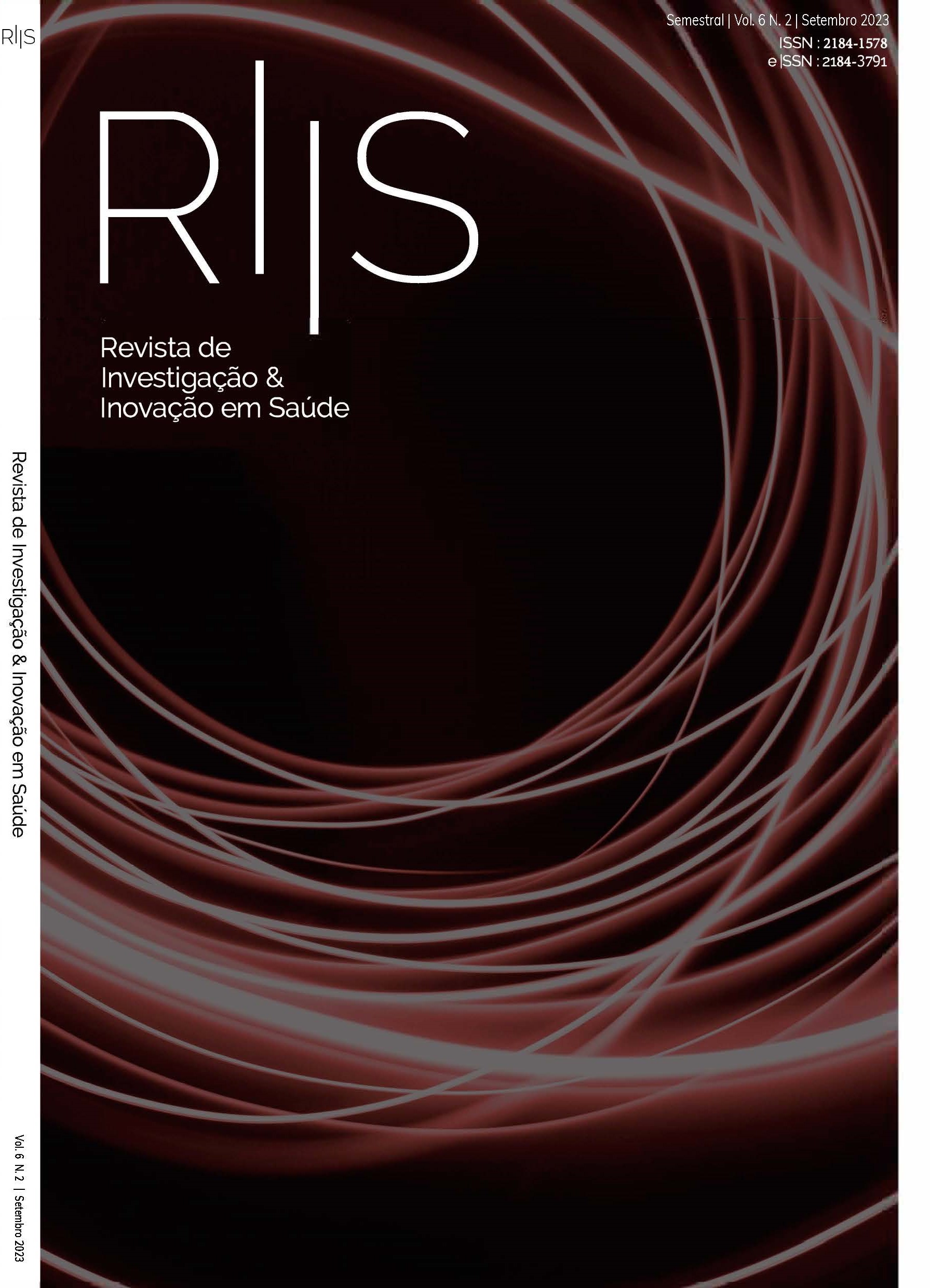Non-pharmacological interventions from nurses to patients with delirium admitted to intensive care – an update
DOI:
https://doi.org/10.37914/riis.v7i2.334Keywords:
nursing care, adult, intensive care, delirium diagnosisAbstract
Background: the person with delirium represents a challenge to health professionals, especially nurses. On the other hand, there are important limitations regarding the pharmacological treatment of this disease. Objectives: to identify the efficacy of non-pharmacological interventions in adults with delirium by intensive care nursing. Methodology: we carried out an integrative review, using electronic bibliographic databases, namely EBSCO and Pubmed MEDLINE, for articles published between 2018 and 2022. The process of selecting articles was based on the recommendations of PRISMA (Preferred Reporting Items for Systematic Reviews and Meta-Analyses) for systematic reviews. Results: nine articles (n=9) were included in the study, of which six correspond to original articles, two to meta-analyses and one systematic review. The non-pharmacological intervention with the greatest available evidence was the multicomponent intervention, although the quality of the studies limits concrete recommendations regarding this approach. Conclusion: the evidence points to the fact that a personalization of care in a complex and integrated perspective is the most effective non-pharmacological approach to delirium.
References
Álvarez, E. A., Garrido, M. A., Tobar, E. A., Prieto, S. A., Vergara, S. O., Briceño, C. D., & González, F. J. (2017). Occupational therapy for delirium management in elderly patients without mechanical ventilation in an intensive care unit: A pilot randomized clinical trial. Journal of critical care, 37, 85–90. https://doi.org/10.1016/j.jcrc.2016.09.002
Bannon, L., McGaughey, J., Verghis, R., Clarke, M., McAuley, D. F., & Blackwood, B. (2019). The effectiveness of non-pharmacological interventions in reducing the incidence and duration of delirium in critically ill patients: a systematic review and meta-analysis. Intensive Care Medicine, 45(1), 1–12. https://doi.org/10.1007/s00134-018-5452-x
Barichello, T., Generoso, J. S., Collodel, A., Petronilho, F., & Dal-Pizzol, F. (2021). The blood-brain barrier dysfunction in sepsis. Tissue Barriers, 9(1), 1840912. https://doi.org/10.1080/21688370.2020.1840912
Barr, J., Fraser, G. L., Puntillo, K., Ely, E. W., Gélinas, C., Dasta, J. F., Davidson, J. E., Devlin, J. W., Kress, J. P., Joffe, A. M., Coursin, D. B., Herr, D. L., Tung, A., Robinson, B. R. H., Fontaine, D. K., Ramsay, M. A., Riker, R. R., Sessler, C. N., Pun, B., … Jaeschke, R. (2013). Clinical Practice Guidelines for the Management of Pain, Agitation, and Delirium in Adult Patients in the Intensive Care Unit. Critical Care Medicine, 41(1), 263–306. https://doi.org/10.1097/CCM.0b013e3182783b72
Bento, A. F. G., & Sousa, P. P. (2021). Delirium in adult patients in intensive care: Nursing interventions. British Journal of Nursing, 30(9), 534–538. https://doi.org/10.12968/bjon.2021.30.9.534
Blevins, C. S., & DeGennaro, R. (2018). Educational Intervention to Improve Delirium Recognition by Nurses. American Journal of Critical Care, 27(4), 270–278. https://doi.org/10.4037/ajcc2018851
Guo, Y., Sun, L., Li, L., Jia, P., Zhang, J., Jiang, H., & Jiang, W. (2016). Impact of multicomponent, nonpharmacologic interventions on perioperative cortisol and melatonin levels and postoperative delirium in elderly oral cancer patients. Archives of Gerontology and Geriatrics, 62, 112–117. https://doi.org/10.1016/j.archger.2015.10.009
Guyatt, G., Oxman, A. D., Akl, E. A., Kunz, R., Vist, G., Brozek, J., Norris, S., Falck-Ytter, Y., Glasziou, P., & DeBeer, H. (2011). GRADE guidelines: 1. Introduction—GRADE evidence profiles and summary of findings tables. Journal of Clinical Epidemiology, 64(4), 383–394. https://doi.org/10.1016/j.jclinepi.2010.04.026
Hamzehpour, H., Valiee, S., Majedi, M. A., Roshani, D., & Seidi, J. (2018). The effect of care plan based on roy adaptation model on the incidence and severity of delirium in intensive care unit patients: A randomised controlled trial. Journal of Clinical and Diagnostic Research, 12(11). https://doi.org/10.7860/JCDR/2018/36366.12256
Inouye, S. K. (1990). Clarifying Confusion: The Confusion Assessment Method. Annals of Internal Medicine, 113(12), 941. https://doi.org/10.7326/0003-4819-113-12-941
Inouye, S. K., Westendorp, R. G., & Saczynski, J. S. (2014). Delirium in elderly people. The Lancet, 383(9920), 911–922. https://doi.org/10.1016/S0140-6736(13)60688-1
Jennings, K. M. (2017). The Roy Adaptation Model. Advances in Nursing Science, 40(4), 370–383. https://doi.org/10.1097/ANS.0000000000000175
Khan, S. H., Xu, C., Purpura, R., Durrani, S., Lindroth, H., Wang, S., Gao, S., Heiderscheit, A., Chlan, L., Boustani, M., & Khan, B. A. (2020). Decreasing Delirium Through Music: A Randomized Pilot Trial. American journal of critical care : an official publication, American Association of Critical-Care Nurses, 29(2), e31–e38. https://doi.org/10.4037/ajcc2020175
Keating, G. M. (2015). Dexmedetomidine: A Review of Its Use for Sedation in the Intensive Care Setting. Drugs, 75(10), 1119–1130. https://doi.org/10.1007/s40265-015-0419-5
Kim, B., Cho, J., Park, J. Y., Kim, H. E., & Oh, J. (2022). Delirium and Anxiety Outcomes Related to Visiting Policy Changes in the Intensive Care Unit During the COVID-19 Pandemic. Frontiers in Aging Neuroscience, 14(March), 1–9. https://doi.org/10.3389/fnagi.2022.845105
Lee, H. J., Bae, E., Lee, H. Y., Lee, S. M., & Lee, J. (2021). Association of natural light exposure and delirium according to the presence or absence of windows in the intensive care unit. Acute and Critical Care, 36(4), 332–341. https://doi.org/10.4266/acc.2021.00556
León-Salas, B., Trujillo-Martín, M. M., Martínez del Castillo, L. P., García-García, J., Pérez-Ros, P., Rivas-Ruiz, F., & Serrano-Aguilar, P. (2020). Multicomponent Interventions for the Prevention of Delirium in Hospitalized Older People: A Meta-Analysis. Journal of the American Geriatrics Society, 68(12), 2947–2954. https://doi.org/10.1111/jgs.16768
Matsuura, Y., Ohno, Y., Toyoshima, M., & Ueno, T. (2022). Effects of non-pharmacologic prevention on delirium in critically ill patients: A network meta-analysis. Nursing in Critical Care, May, 1–11. https://doi.org/10.1111/nicc.12780
Neelon, V. J., Champagne, M. T., Carlson, J. R., & Funk, S. G. (1996). The NEECHAM Confusion Scale: Construction, Validation, And Clinical Testing. Nursing Research, 45(6), 324–330. https://doi.org/10.1097/00006199-199611000-00002
Olmos, M., Varela, D., & Klein, F. (2019). ENFOQUE ACTUAL DE LA ANALGESIA, SEDACIÓN Y EL DELIRIUM EN CUIDADOS CRÍTICOS. Revista Médica Clínica Las Condes, 30(2), 126–139. https://doi.org/10.1016/j.rmclc.2019.03.002
Page, M. J., McKenzie, J. E., Bossuyt, P. M., Boutron, I., Hoffmann, T. C., Mulrow, C. D., Shamseer, L., Tetzlaff, J. M., Akl, E. A., Brennan, S. E., Chou, R., Glanville, J., Grimshaw, J. M., Hróbjartsson, A., Lalu, M. M., Li, T., Loder, E. W., Mayo-Wilson, E., McDonald, S., McGuinness, L. A., … Moher, D. (2021). The PRISMA 2020 statement: an updated guideline for reporting systematic reviews. BMJ (Clinical research ed.), 372, n71. https://doi.org/10.1136/bmj.n71
Poole, J., & Ray, D. (2022). The Role of Circadian Clock Genes in Critical Illness: The Potential Role of Translational Clock Gene Therapies for Targeting Inflammation, Mitochondrial Function, and Muscle Mass in Intensive Care. Journal of Biological Rhythms, 37(4), 385–402. https://doi.org/10.1177/07487304221092727
Pun, B. T., Balas, M. C., Barnes-Daly, M. A., Thompson, J. L., Aldrich, J. M., Barr, J., Byrum, D., Carson, S. S., Devlin, J. W., Engel, H. J., Esbrook, C. L., Hargett, K. D., Harmon, L., Hielsberg, C., Jackson, J. C., Kelly, T. L., Kumar, V., Millner, L., Morse, A., … Ely, E. W. (2019). Caring for Critically Ill Patients with the ABCDEF Bundle. Critical Care Medicine, 47(1), 3–14. https://doi.org/10.1097/CCM.0000000000003482
Trogrlić Z, van der Jagt M, Bakker J, Balas MC, Ely EW, van der Voort PH, Ista E. A systematic review of implementation strategies for assessment, prevention, and management of ICU delirium and their effect on clinical outcomes. Crit Care. 2015 Apr 9;19(1):157. doi: 10.1186/s13054-015-0886-9. PMID: 25888230; PMCID: PMC4428250.
Rains, J., & Chee, N. (2017). The role of occupational and physiotherapy in multi-modal approach to tackling delirium in the intensive care. Journal of the Intensive Care Society, 18(4), 318–322. https://doi.org/10.1177/1751143717720589
Schuckit, M. A. (2014). Recognition and Management of Withdrawal Delirium (Delirium Tremens). New England Journal of Medicine, 371(22), 2109–2113. https://doi.org/10.1056/NEJMra1407298
Wilson, C. J., Finch, C. E., & Cohen, H. J. (2002). Cytokines and Cognition-The Case for A Head-to-Toe Inflammatory Paradigm. Journal of the American Geriatrics Society, 50(12), 2041–2056. https://doi.org/10.1046/j.1532-5415.2002.50619
Downloads
Published
How to Cite
Issue
Section
License
Copyright (c) 2024 Fábio Emanuel Quintal Fernandes, Orlando Ferro Fernandes, Isabel Abreu, Hugo Canas-Simião, Filipe Vieira Franco

This work is licensed under a Creative Commons Attribution 4.0 International License.















